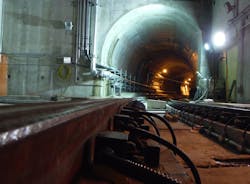The Wheel Whisperer: Sound Transit’s Good Neighbor Program
Sound Transit needed to expand but the desired route went right under advanced research facilities at the University of Washington (UW) where unexpected vibrations could compromise critical projects.
With UW’s delicate research and medical facilities, it would not grant the right of way unless Sound Transit could prove that there would be zero vibration impact.
An intelligent, vibration and flat spot monitoring system with increased sensitivity, reliability, flexibility and utility would enable Sound Transit train operators to ensure that no trains with wheel flats or other unacceptable vibration would enter the critical zone.
Sound Transit had to demonstrate to the university, that its train operations would have no discernible impact on the neighboring research centers. Given the requirements, there were valid concerns as to whether the ongoing operations of the urban rail system could meet those requirements.
After 2-1/2 years of work, Sound Transit has now reported that the system is up and running and meeting all internal goals and expectations.
Innovation Throughout
The sound and vibration and wheel flat monitoring system consists of four key elements:
A vibration monitoring system that incorporates the first commercial application of calibrated ultrasensitive vibration measurement sensors.
A wheel flat detection system that uses sophisticated signal processing to identify small flat spots before they reach the point of damaging the wheel, the rail and the suspension system, not to mention impacting the public; too small to be audible to the human ear.
A mobile monitoring system that could be installed at a variety of locations between the rail line and the UW buildings sensitive locations, such as a wafer fab facility or medical research lab, to acquire quantifiable performance data regarding the actual rates of sound and vibration transmission through the unique geography and subsurface soil conditions specific to the location of each critical UW building and the train system.
A smart infrastructure monitoring system (SIMStm), a robust, redundant communications network, employing high-level data mining and data analytics to provide report alarm generation capacity in real time (within one second) on a 24/7 basis for machine-to-machine, as well as machine-to-human reporting for UW officials, Sound Transit administrators, Sound Transit maintenance personnel, and the IEM monitoring team.
In normal rail operations, the frequent stopping and starting of light rail vehicles, especially on wet rail very often result in the development of “slid flat spots” on the wheel. When the wheel slides, a flat spot develops on the wheel and then each time that wheel revolves, that flat spot acts as a jack hammer, pounding the rail, damaging the suspension equipment and sending out both audible and inaudible signals through the air and ground.
Without early intervention, flat spots tend to grow each time the train stops.
Since there is no proven technology to avoid the development of flat spots, the only option is to detect them and repair them by truing the wheel. Since flat spots are the most significant factor that could result in Sound Transit becoming out of compliance with the terms of its contract with the university, the first order of business was to create a flat spot detector which could provide maintenance managers and train operators a head’s up prior to a wheel flat reaching or even approaching a critical condition. The wheel flat systems are located miles from the UW campus, providing Sound Transit an early warning capability to take action before the prior to the train reaching any sensitive buildings.
Learning the Language of Trains Wheels
To meet the performance specifications required by the Sound Transit application, IEM developed signal processing algorithms which resulted in higher sensitivity and responsiveness than any other technology available. This increased sensitivity creates the ability to reduce the number of sensors which reduces cost while enhancing its ability to detect smaller signals which both allows the detection of smaller flat spots and the reliable detection of flat spots at slower train speeds.
The first step was to realize that the signal created by a flat spot propagates through the rail so rapidly (compared with the forward motion of the wheels) that all of the sensors essentially picked up the wheel flat signal simultaneously. This realization lead to a software design that sums and averages the signals from each sensor. In this operation, random background noise tends to be self-cancelling while the repeated signals accumulate. The result is a dramatic, low-cost increase in the signal to noise. But more was needed.
They had to learn the language of wheelstrains. To do that required the application of cepstrum cepstral analysis.
Cepstrum cepstral analysis is one of the foundational building blocks of the language recognition software now ubiquitous in cellphones. By applying the technology of language recognition to the sound generated by passing trains, the system learned to identify the whisper of flat spots that were too small to be heard by the human ear at train speeds as low as 8 mph but which, upon subsequent inspection, were found to be there. This capacity is enhanced by the use of cross-statistical analysis using data from multiple sources to uncover conditions which could not be discerned from a single-source data analysis.
By concentrating the system’s development work on the signal processing component as opposed to the hardware, the IEM system wound up generating the benefits of lower costs, increased effectiveness, extended range and improved reliability.
In daily operations, the wheel flat detection system automatically alerts train controllers when it detects a flat wheel. Then, depending on the severity of the flat spot, the train controllers can order the train out of service before it enters the critical zone, or can issue a go-slow order to the train reducing the noise generated by the flat spot. Calibration is currently taking place to develop algorithms relating impact severity with train speed, load and the external vibrations being monitored by the vibration monitoring system.
The Smart Infrastructure Monitoring System includes several technical innovations to ensure that the raw data generated by the array of sensors are converted into meaningful, actionable information that is delivered to the right locations in a useful timeframe. This communications challenge is more daunting than it might initially appear.
To achieve the most reliable but cost-effective solution, the overall system design uses distributed processing and analytics to reduce the demands on the communications network system while simultaneously time stamping the data generated from each location so higher trend analysis can be conducted.
The system also incorporates self-monitoring as an essential function.
There are two levels of alerts. Exceedance alerts, such as an impact with the potential to create vibrations which might reach the protected zone, are set at fixed levels based on the requirements established by the University of Washington and cannot be changed.
However, Sound Transit maintenance engineers have the ability to adjust the warning level alerts so they can balance the sensitivity of the system with the work load and capacity of their maintenance resources. Alert notification utilizes email, text messages and alarm activation.
The result is a robust system that provides around-the-clock actionable information when and where it is needed to eliminate potential failures before they happen.
According to Zack Mian, President of IEM, “If you think of a wheel with a flat spot as a wheel that’s shouting, our system helps Sound Transit to hear that wheel when it’s still a whisper. And in urban transit, whispering wheels make good neighbors.”
Richard Arthur is with IEM Corp.



